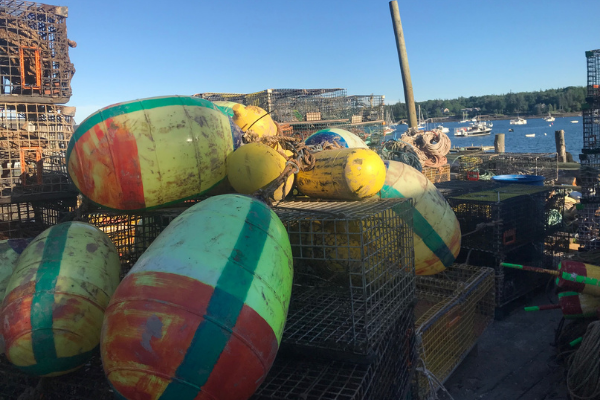
American Chemical Society | Industry | Industry Matters Newsletter | Plastics Everywhere
Plastics Everywhere
Industry Matters Newsletter August 5, 2021
Oh, the plastic! Everywhere I look there is plastic.
I am exploring the bays and ocean around Maine’s Acadia National Park by kayak. Acadia is an area of great natural beauty, but is also home to several ports with centuries of uninterrupted use. These are working ports, developed to harvest the ocean’s bounty. The harvest continues today with fish and lobster flowing through the ports.
Looking forward, the bow of my kayak is plastic. My paddle is a beautiful cedar strip creation, made possible due to the epoxy and urethane coatings that protect the wood. More plastic.
The water around me is dotted with floats attached to lobster pots. In past years, these would have been cork and wood, painted to indicate the owner. Plastic foam replaced cork. Wood replaced by rigid plastic.
Hemp or other natural fiber rope was used in the past. Today, the floats connect to the lobster pots with rot-resistant nylon or polyolefin.
Yesterday’s iconic lobster trap was made of wooden slats arrayed to form a half cylinder outfitted with netting made from natural fiber. Today’s traps are plastic coated steel with plastic netting, rectangular in overall shape. Wooden lath pots still find use as decoration, but pots on the docks and decks are not wooden.

Captured lobsters are stored in floating plastic cages, rafted together with plastic rope. They attach to floating docks, buoyant due to plastic floats.
Lobster boats are a mix of historic and modern. Wooden vessels protected with brightly colored paint, polymer-based paints, are common. More modern boats are constructed using plastic.
I expected to see plastic in the water. I’d steeled myself to be disappointed by plastic fouling the beautiful scenery, knowing full-well much of the concern is about microplastics I can’t see. Plastic trash is very rare in my travels around Mount Desert Island. As I always do, I pick up trash when I see it. I picked up only two pieces in five days on the water. Lack of visible plastic gives hope, hope significant amounts aren’t slipping into the environment to be reduced to smaller pieces. I am relieved, relieved the plastic I see around Acadia is intentionally there. Acadia Lobster Trap
Dinner menus brag about serving sustainably harvested Maine seafood. Efforts to maintain Maine’s lobster fishery date back more than a century. Restrictions on harvest of breeding females, small, and large lobsters started out as voluntary, now the law. It is a robust fishery, with lobster harvests in the Gulf of Maine and George’s Bank continuing to grow.
As I paddle, lobster boats are pulling their pots. I hear the throb of diesel engines and see the exhaust trailing the boats. I think back to the menu claim, trying to reconcile use of the adjective sustainable. Sustainability, in the absolute, is about leaving resources for future generations. In a sustainable world, future generations will be able to afford themselves of all the resources at my disposal, in the same quantity and with the same accessibility. The fishery definition is much narrower, focusing only on the catch. It is about maintaining a stable population. Resources used in pursuit of the catch don’t figure in.
Years in the chemical industry drive me to first associate raw material sourcing, emissions, and environmental plastic with sustainability. Sustainability encompasses more, but these three are front-and-center for chemicals. Sitting in Acadia, I see fossil fuels being burned to fuel the harvest. I observe air freight trucks on the piers, loading the harvest for distribution using fossil fuel burning planes. I see plastic, made from fossil resources, in use everywhere I look. I see plastics in the environment everywhere I look, plastics that degrade by the action of sun, wind, and wave. Sustainably harvested doesn’t seem accurate.
Natural, biodegradable materials gave way to plastic. History shows lobsterman of old spent hours each day repairing equipment. I haven’t observed any repairs happening. Plastic is a miracle material, significantly reducing hours spent repairing equipment. It is cheaper than alternatives and lasts longer. Sails gave way to fossil-fuel burning engines. Compelling economics drove adoption for both.
The Gulf of Maine fishery is a case, certainly not a unique case, where renewable, more sustainable options were displaced. Plastic replaced well-developed options based on natural materials. I am left pondering how we roll back the clock, decreasing plastic use to reduce persistent particles in the environment. Pondering whether biodegradable alternatives for the rope, floats, traps and more can displace the superior performance of plastics. Pondering whether there is enough cork and sisal to displace the plastic. Pondering what incentives will drive adoption of materials with higher cost and reduced performance. Pondering whether renewables could again power the fleet. Pondering how much already expensive lobster will cost in the future. Pondering whether I can reconcile the costs.